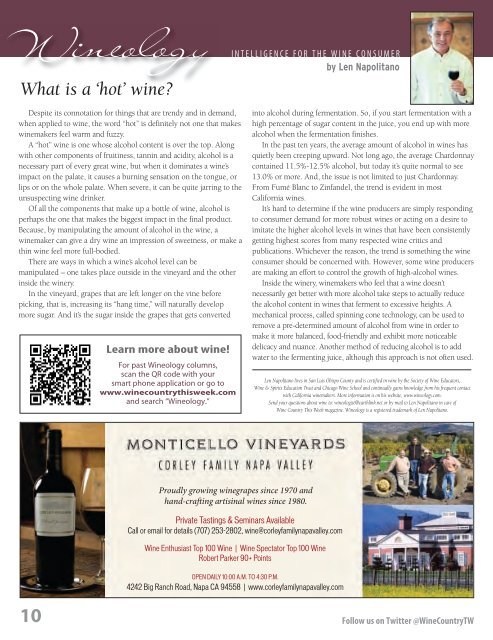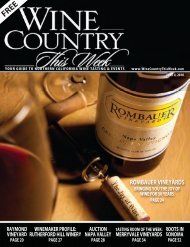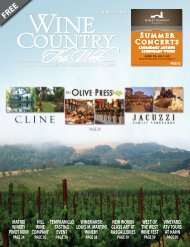View As PDF - Wine Country This Week
View As PDF - Wine Country This Week
View As PDF - Wine Country This Week
Create successful ePaper yourself
Turn your PDF publications into a flip-book with our unique Google optimized e-Paper software.
What is a ‘hot’ wine?<br />
I N T E L L I G E N C E F O R T H E W I N E C O N S U M E R<br />
by Len Napolitano<br />
Despite its connotation for things that are trendy and in demand,<br />
when applied to wine, the word “hot” is definitely not one that makes<br />
winemakers feel warm and fuzzy.<br />
A “hot” wine is one whose alcohol content is over the top. Along<br />
with other components of fruitiness, tannin and acidity, alcohol is a<br />
necessary part of every great wine, but when it dominates a wine’s<br />
impact on the palate, it causes a burning sensation on the tongue, or<br />
lips or on the whole palate. When severe, it can be quite jarring to the<br />
unsuspecting wine drinker.<br />
Of all the components that make up a bottle of wine, alcohol is<br />
perhaps the one that makes the biggest impact in the final product.<br />
Because, by manipulating the amount of alcohol in the wine, a<br />
winemaker can give a dry wine an impression of sweetness, or make a<br />
thin wine feel more full-bodied.<br />
There are ways in which a wine’s alcohol level can be<br />
manipulated – one takes place outside in the vineyard and the other<br />
inside the winery.<br />
In the vineyard, grapes that are left longer on the vine before<br />
picking, that is, increasing its “hang time,” will naturally develop<br />
more sugar. And it’s the sugar inside the grapes that gets converted<br />
Learn more about wine!<br />
For past <strong>Wine</strong>ology columns,<br />
scan the QR code with your<br />
smart phone application or go to<br />
www.winecountrythisweek.com<br />
and search “<strong>Wine</strong>ology.”<br />
into alcohol during fermentation. So, if you start fermentation with a<br />
high percentage of sugar content in the juice, you end up with more<br />
alcohol when the fermentation finishes.<br />
In the past ten years, the average amount of alcohol in wines has<br />
quietly been creeping upward. Not long ago, the average Chardonnay<br />
contained 11.5%-12.5% alcohol, but today it’s quite normal to see<br />
13.0% or more. And, the issue is not limited to just Chardonnay.<br />
From Fumé Blanc to Zinfandel, the trend is evident in most<br />
California wines.<br />
It’s hard to determine if the wine producers are simply responding<br />
to consumer demand for more robust wines or acting on a desire to<br />
imitate the higher alcohol levels in wines that have been consistently<br />
getting highest scores from many respected wine critics and<br />
publications. Whichever the reason, the trend is something the wine<br />
consumer should be concerned with. However, some wine producers<br />
are making an effort to control the growth of high-alcohol wines.<br />
Inside the winery, winemakers who feel that a wine doesn’t<br />
necessarily get better with more alcohol take steps to actually reduce<br />
the alcohol content in wines that ferment to excessive heights. A<br />
mechanical process, called spinning cone technology, can be used to<br />
remove a pre-determined amount of alcohol from wine in order to<br />
make it more balanced, food-friendly and exhibit more noticeable<br />
delicacy and nuance. Another method of reducing alcohol is to add<br />
water to the fermenting juice, although this approach is not often used.<br />
Len Napolitano lives in San Luis Obispo County and is certified in wine by the Society of <strong>Wine</strong> Educators,<br />
<strong>Wine</strong> & Spirits Education Trust and Chicago <strong>Wine</strong> School and continually gains knowledge from his frequent contact<br />
with California winemakers. More information is on his website, www.wineology.com.<br />
Send your questions about wine to: wineologist@earthlink.net or by mail to Len Napolitano in care of<br />
<strong>Wine</strong> <strong>Country</strong> <strong>This</strong> <strong>Week</strong> magazine. <strong>Wine</strong>ology is a registered trademark of Len Napolitano.<br />
10<br />
Follow us on Twitter @<strong>Wine</strong><strong>Country</strong>TW

















